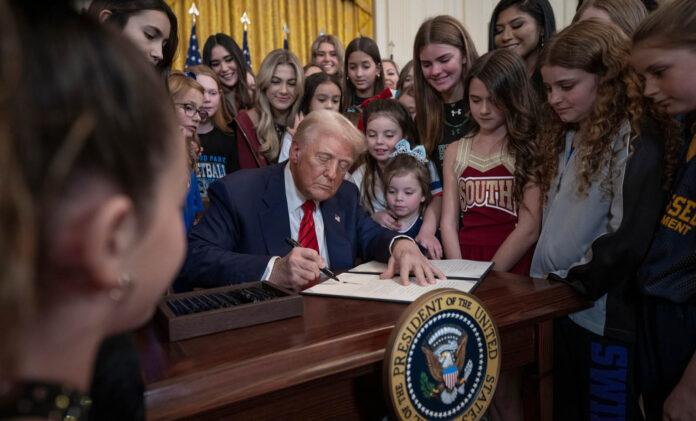By: Ashley Ann Reich
On January 20, 2025, President Donald J. Trump was sworn in as the 47th President of the United States. Regardless of your political views, this was a monumental day in history as President Trump had just completed his first term as President just two election cycles prior. As someone who has been involved in the prior Trump Administration work at the federal level, this day was full of anticipation mainly due to the fact that this was not President Trump’s “first rodeo” and it was clear that he would quickly upend many processes and policies based on campaign promises. This article aims to provide an overview of the First 100 Days of President Trump in office and does not intend to provide political bias to one administration over the other. One thing is for certain – change is inevitable.
On Day 1 of President Trump taking office, he and his team went to work on publishing multiple Executive Orders (EO). An Executive Order is a “signed, written, and published directive from the President of the United States that manages operations of the federal government, and is signed consecutively.” There are two other types of presidential documents, which include proclamations, which typically deal with information on holidays, commemorations, federal observances, and trade and administrative orders, which could be more like a memo, notice, letter, or message. The unique aspect of Executive Orders is that the incoming President does not inherit the past administration’s Executive Order list and, essentially, expires. America saw a mixture of the types of orders on that first day, but most included Executive Orders.
Notable Executive Orders on Day 1 –
There were several notable EOs that President Trump issued on the first day that included the renaming of two landmarks – the Gulf of Mexico to the ‘Gulf of America’ and Denali back to ‘Mount McKinley’. Additionally, other actions taken by President Trump were to grant clemency to all connected with the January 6, 2021, attacks on the Capitol, and delayed the enforcement of a federal ban on the popular social media platform, TikTok. It is safe to say that the entire world was watching as these decisions were handed down and had a great impact globally.
Major Themes –
The Trump Administration did not waste any time crafting Executive Orders and providing clear and unprecedented guidance to many federal agencies. As decisions were being made and individuals were brought on to the Trump Administration, several themes began to emerge that gave us an idea of what to expect in the days and months ahead.
The Theme of Efficiency – On January 20th, President Trump created the Department of Government Efficiency or DOGE and placed Tesla mogul, Elon Musk, in charge. The agency was directed to focus on modernizing technology and software to maximize governmental efficiency and productivity. Almost immediately, DOGE went to work on reviewing areas to cut down on unnecessary spending throughout the government. As taxpayers, the idea of cutting down on spending seemed positive, in theory, but that came with the difficulty of many government employees either being laid off indefinitely or terminated. This newly created agency has an 18-month expiration date (or by July 4, 2026), and it is unknown if the foundation that has been laid to create efficiencies and curb government spending will continue on past that date, if it even makes it that long.
The Theme of Trade Policy – On January 21st, only his second day in office, President Trump issued a statement about reviewing the U.S. trade policy, particularly with Canada and Mexico, to protect American families and workers. As a result of this statement, an Executive Order was issued to review trade issues and policies. As several months have gone by, the imposition of tariffs for several countries took effect, but most notably, the highest tariff was issued for China at a whopping 34%. This announcement of the tariffs sent shockwaves through the stock market, and the market began to tank. Most Americans who had money tied up in the stock market quickly saw their stocks decrease rapidly, and the damage came in right around $10 trillion across global equities over a 7-day period. President Trump recently pushed pause on some of the tariff timelines, which allowed the market to recover, but not all losses have been recovered.
The Theme of Education – On March 20th, Secretary Linda McMahon reacted with full support to President Trump’s accompanying Executive Order around dismantling the U.S. Department of Education and sending education back to the states. Both higher education and K-12 have watched closely as President Trump has fulfilled many campaign promises around ending Diversity, Equity, and Inclusion initiatives, protecting women in sports, and launching over 60 investigations into schools related to antisemitic discrimination and harassment. There has been much speculation as to the probability of being able to eliminate the U.S. Department of Education altogether, but what seems to be more likely is the relocation of various departments and tasks to other agencies for better management and oversight.
On the Horizon –
As noted at the beginning, there has been a large list of Executive Orders completed in short order – 124 as of April 15th,to be exact. It is expected that we should begin to see laws and regulations contemplated, and action items that were directives to various agencies within the orders fulfilled. One byproduct of some of the Executive Orders issued has been the introduction of litigation to challenge presidential directives. We have already witnessed judges’ ruling on various aspects to either allow the action to continue or to place a “stay” on the item for additional review.
Agencies like the U.S. Department of Education have begun drafting their priorities for the rulemaking process and taking public comments as recently as April 4. This is a process that federal agencies must use to craft and finalize regulations that are intended to fall in line with presidential directives and priorities. Congress will also begin to work across the aisle to discuss laws that will need to change, which can be a lengthy and chaotic process.
If the first 100 days are anything like the next 100 days, Americans should be ready to see consistent and rapid change. It is clear that the Trump Administration is not wasting time the second time around and has had the luxury of not needing a “honeymoon period” in the White House to get their bearings and establish priorities. To end on a personal note, I always encourage getting involved in issues that are most important to you. Make phone calls, write letters, and visit your state and federal representatives to voice issues of concern as well as items of support. Advocacy is a worthwhile endeavor and is required to be a change agent in our society today.

ABOUT THE AUTHOR
Ashley Ann Reich has been with Liberty University since 2007, first working in Student Financial Services and then as Executive Director of Government Affairs before transitioning to her current role as Senior Vice President of University Compliance. During her time at LU, Ashley started the first financial literacy program, reaching thousands of students in budgeting, paying down debt, and planning for the future.










